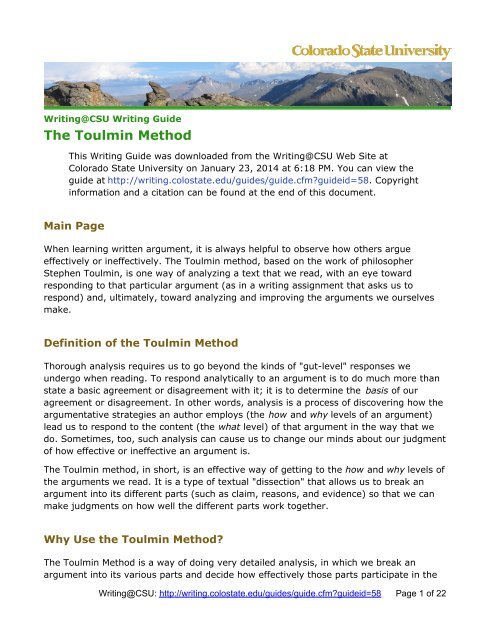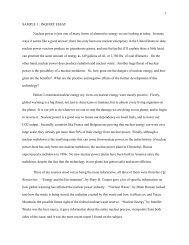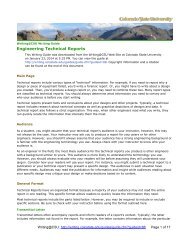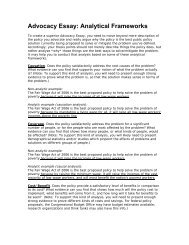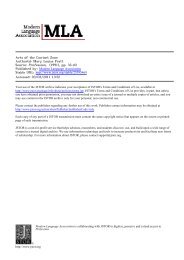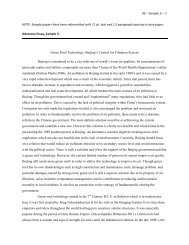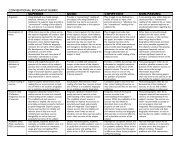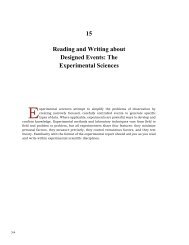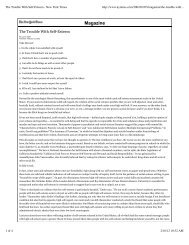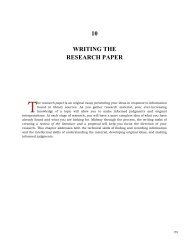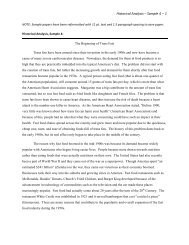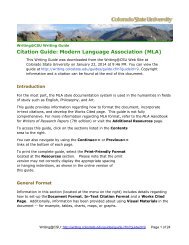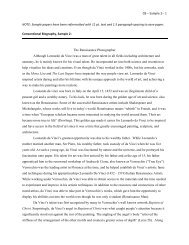Writing@CSU Writing Guide: The Toulmin Method
Writing@CSU Writing Guide: The Toulmin Method
Writing@CSU Writing Guide: The Toulmin Method
- No tags were found...
Create successful ePaper yourself
Turn your PDF publications into a flip-book with our unique Google optimized e-Paper software.
<strong><strong>Writing</strong>@CSU</strong> <strong>Writing</strong> <strong>Guide</strong><strong>The</strong> <strong>Toulmin</strong> <strong>Method</strong>This <strong>Writing</strong> <strong>Guide</strong> was downloaded from the <strong><strong>Writing</strong>@CSU</strong> Web Site atColorado State University on January 23, 2014 at 6:18 PM. You can view theguide at http://writing.colostate.edu/guides/guide.cfm?guideid=58. Copyrightinformation and a citation can be found at the end of this document.Main PageWhen learning written argument, it is always helpful to observe how others argueeffectively or ineffectively. <strong>The</strong> <strong>Toulmin</strong> method, based on the work of philosopherStephen <strong>Toulmin</strong>, is one way of analyzing a text that we read, with an eye towardresponding to that particular argument (as in a writing assignment that asks us torespond) and, ultimately, toward analyzing and improving the arguments we ourselvesmake.Definition of the <strong>Toulmin</strong> <strong>Method</strong>Thorough analysis requires us to go beyond the kinds of "gut-level" responses weundergo when reading. To respond analytically to an argument is to do much more thanstate a basic agreement or disagreement with it; it is to determine the basis of ouragreement or disagreement. In other words, analysis is a process of discovering how theargumentative strategies an author employs (the how and why levels of an argument)lead us to respond to the content (the what level) of that argument in the way that wedo. Sometimes, too, such analysis can cause us to change our minds about our judgmentof how effective or ineffective an argument is.<strong>The</strong> <strong>Toulmin</strong> method, in short, is an effective way of getting to the how and why levels ofthe arguments we read. It is a type of textual "dissection" that allows us to break anargument into its different parts (such as claim, reasons, and evidence) so that we canmake judgments on how well the different parts work together.Why Use the <strong>Toulmin</strong> <strong>Method</strong>?<strong>The</strong> <strong>Toulmin</strong> <strong>Method</strong> is a way of doing very detailed analysis, in which we break anargument into its various parts and decide how effectively those parts participate in the<strong><strong>Writing</strong>@CSU</strong>: http://writing.colostate.edu/guides/guide.cfm?guideid=58 Page 1 of 22
overall whole. When we use this method, we identify the argument's claim, reasons, andevidence, and evaluate the effectiveness of each.However, it can be said that <strong>Toulmin</strong> works somewhat like a formula to be applied toarguments, and that as such it exhibits some limitations. It is often not very well applied,for example, to arguments that are not themselves organized in a linear way and writtenin the tradition of Western rhetoric. And, as Timothy Crusius and Carolyn E. Channellpoint out in <strong>The</strong> Aims of Argument, this method is limited to logical analysis, andtherefore excludes other types of evaluation/analysis which are equally important (suchas the Critical Reading strategies mentioned elsewhere in the <strong>Writing</strong> Center.) But<strong>Toulmin</strong> proves for many to be a good starting point.Parts of an ArgumentUsing the <strong>Toulmin</strong> method requires that we take an argument apart and examine itsvarious elements. This "dissection" allows us to understand the argument more fully,summarize it more accurately, and discuss its effectiveness or ineffectiveness moreintelligently than we would have otherwise.It might be helpful to envision writing the parts of an argument like building a house ofcards, in which you work backwards, beginning with the uppermost level (the claim).Each level is balanced precariously on the level beneath it. And in order for an argumentto hold up under careful scrutiny, each level must be strong enough to support what isplaced on top of it.<strong>The</strong> ClaimThink of the claim in an argument as the most general statement in that argument. Itmay not be a particularly general statement all by itself, and some for arguments arevery narrow indeed. But the claim is like the umbrella statement that all other parts of anargument have to fall under. It is the uppermost level of our "house of cards."After you have identified an argument's claim, it is important to determine how far theauthor intends to carry that claim. <strong>The</strong> next step in this process, in other words, is theidentification of any qualifiers or exceptions the author makes to the argument's claim.Identifying QualifiersQualifiers are words like some, most, many, in general, usually, typically and so on--littlewords whose value to an argument is immeasurable.Example of a qualified claim:Many books by Charles Dickens are fun to read.Example of an unqualified claim:<strong><strong>Writing</strong>@CSU</strong>: http://writing.colostate.edu/guides/guide.cfm?guideid=58 Page 2 of 22
Books by Charles Dickens are fun to read.Without qualifying words like some or many, a claim like this can be interpreted (by thecareful analytical eye) as All books by Charles Dickens are always fun for everyone toread.Although unqualified claims like these are not necessarily a bad argumentation strategy,they do allow ample room for challenges to be made to an argument. An appropriatelyqualified claim is much easier to defend.Identifying ExceptionsOftentimes, an author will specifically exclude from an argument certain cases orsituations. Such exceptions serve to restrict a claim, so that it is understood to apply insome situations but not in others.A claim likeMost books by Charles Dickens are fun to read.might be limited by the following exception:Having labored over David Copperfield in high school, I would not rank thatbook among them.Exceptions like this one are important, because without them, readers who would like tochallenge a claim may begin to concoct exceptions of their own.Distinguishing Between Qualifiers and ExceptionsQualifiers and exceptions are similar in that they both put limits on how far a claim maybe carried. A qualifier, however, is merely a word (like some or usually) which serves tolimit a claim, while an exception is an e xample of a case or situation in which the claimdoes not apply.An example of a qualifier would be the word most in the following claim:Most books by Charles Dickens are fun to read.An exception would be an example, usually appearing after the claim, of a situation inwhich that claim would not apply:Having labored over David Copperfield in high school, I would not rank thatbook among them.<strong>The</strong> ReasonsWhy does a writer believe the claim s/he makes? <strong>The</strong> reasons a writer gives are the firstline of development of any argument. To use our "house of cards" image again, reasons<strong><strong>Writing</strong>@CSU</strong>: http://writing.colostate.edu/guides/guide.cfm?guideid=58 Page 3 of 22
sufficient, credible , and accurate.Determining the Sufficiency of EvidenceAs you look at the evidence supporting a reason, ask yourself if the author makes use ofenough evidence to convince a reasonable reader.If one reason given in an argument isIf you look at writing assignments given in various disciplines of the university,you will find that many of them include elements that are related in some wayto argument.An example from one Engineering assignment would most likely be insufficient, whereseveral such examples would provide a more varied range of situations in which thestated reason holds true.Determining the Credibility of EvidenceIt is important to decide how credible (believable and authoritative) a piece of evidence iswithin an argument. As you look at the evidence supporting a reason, ask yourselfwhether or not this evidence matches with readers' experience of the world. If it doesn't,does the evidence come from a source that readers would accept as more knowledgeableor authoritative than they are?If one reason given in an argument isOn the university level, argument is valued by professors of various disciplineswho say that they would like for their students to be able to take a strongposition and support it with ample reasons and evidence, statistics taken from <strong>The</strong> Nationa<strong>The</strong> National Inquirerand given in support of this reason will typically be muchless credible than ones taken from <strong>The</strong> Journal of Higher Education.Determining the Accuracy of EvidenceAs you look at the evidence supporting a reason, ask yourself if this evidence "tells thetruth." Are statistics gathered in verifiable ways from good sources? Are the quotationscomplete and fair (not out of context)? Are the facts verifiable from other sources?Sometimes it is difficult to determine accuracy without having the writer's sources infront of you, but there are oftentimes cases in which you will be suspicious of a piece ofevidence for one reason or another.If, in support of a reason likeCollege students are very enthusiastic about learning argumentation skillsa writer uses this piece of evidence:In a survey conducted in my residence hall, 92% of the respondents assertedthat they enjoyed writing arguments more than any other activity listed on the<strong><strong>Writing</strong>@CSU</strong>: http://writing.colostate.edu/guides/guide.cfm?guideid=58 Page 5 of 22
questionnaire,you might be led to ask questions like "Who conducted this survey?" "Who were theserespondents?" or "What were the other activities listed on the questionnaire?"Anticipated Objections and RebuttalWhen we analyze an argument using the <strong>Toulmin</strong> method, we look for potentialobjections to the argument's reasons, objections which the writer expects his or heropponents to make. Usually, these are included in arguments as opportunities for thewriter to present her or his own reasons as refutations/rebuttals.Example of an Anticipated ObjectionIf one reason in an argument is:On the university level, argument is valued by professors of various disciplineswho say that they would like for their students to be able to take a strongposition and support it with ample reasons and evidence,the writer might hold up the following objection:Many students argue that fields like Engineering and Math have no use forargumentation skills.Once a writer identifies counter-arguments opponents might make, it would beself-defeating to announce those counter-arguments and not argue against them.<strong>The</strong>refore, after stating the objections of opponents, most writers will refute or rebut theobjections. Good rebuttal usually requires evidence, so don't forget to look for support forthe rebuttal position in that part of an argument. Like all evidence, rebuttal evidenceshould be sufficient, accurate, and credible.Example of a RebuttalTo the anticipated objection:Many students argue that fields like Engineering and Math have no use forargumentation skills,a writer might offer the following rebuttal evidence,However, a recent study appearing in journal, Language and Learning Acrossthe Disciplines indicates that...(fill in the blank)Drawing Conclusions from a <strong>Toulmin</strong> AnalysisOnce you have completed a <strong>Toulmin</strong> analysis of an argument, your task is to collect your"results" into an overall, coherent statement about the effectiveness of that argument. In<strong><strong>Writing</strong>@CSU</strong>: http://writing.colostate.edu/guides/guide.cfm?guideid=58 Page 6 of 22
other words, if you are attempting to respond to that argument--whether in a formalresponse essay or in an arguing essay where you are using the argument as evidence oras opposing evidence--you will need to shape your <strong>Toulmin</strong> results into a coherent,defensible, narrow claim of your own. To see an example of how you would do this, youmight go to the relevant part of the <strong>Toulmin</strong> demonstration.<strong>Toulmin</strong> WorksheetClick below to access a copy of a <strong>Toulmin</strong> Worksheet, so that you may practice using the<strong>Toulmin</strong> <strong>Method</strong> of analysis on your own, using an argument in a text of your own choice.Remember, as you use this worksheet, that not all elements of an argument are nearly asformulaic as the sheet might suggest. <strong>The</strong> argument you use might, for instance, usemore than three reasons, or it might use only one. Think of this worksheet as a startingpoint, and feel free to make whatever changes are necessary to incorporate the elementsyou identify in the argument you are examining.Related Information: <strong>Toulmin</strong> WorksheetA <strong>Toulmin</strong> Model for Analyzing Arguments(modified from Timothy W. Crusius and Carolyn E. Channell, <strong>The</strong> Aims of Argument, p.34)Claim:Qualifier?Exceptions?***************Reason 1What makes this reason relevant?What makes this reason effective?What evidence supports this reason?Is this evidence sufficient?Is this evidence credible?Is this evidence accurate?Reason 2<strong><strong>Writing</strong>@CSU</strong>: http://writing.colostate.edu/guides/guide.cfm?guideid=58 Page 7 of 22
What makes this reason relevant?What makes this reason effective?What evidence supports this reason?Is this evidence sufficient?Is this evidence credible?Is this evidence accurate?Reason 3What makes this reason relevant?What makes this reason effective?What evidence supports this reason?Is this evidence sufficient?Is this evidence credible?Is this evidence accurate?***************************************************************Objection:Rebuttal:Objection:Rebuttal:Objection:Rebuttal:<strong><strong>Writing</strong>@CSU</strong>: http://writing.colostate.edu/guides/guide.cfm?guideid=58 Page 8 of 22
<strong>Toulmin</strong> DemonstrationWhat follows is a sample student argument, analyzed by way of the <strong>Toulmin</strong> <strong>Method</strong>. Itoffers an example of how this method might be implemented as a way of breaking anargument into its parts, then examining those parts to see how they contribute to theoverall effectiveness or ineffectiveness of the argument.Example Student ArgumentLandscaping that Makes Sense for the WestWhen I moved here from Ohio twelve years ago, I cared for my lawn the way I didin Ohio--rather the way I didn't care for my lawn in Ohio. In southern Ohio, I neverhad to water my half acre of Kentucky bluegrass. And although I never sprayed mylawn with herbicide (weed killers), the neighbors all did and the grass grew so thickthat I had very few weeds. What I did do was mow, and mow constantly! <strong>The</strong>re wasnever a summer evening or weekend when I couldn't hear the roar of a lawn mowersomewhere in the neighborhood. When I practiced this level of lawn care on mybluegrass here in Fort Collins, I ended up with a sorry-looking, balding brown patchof weed-infested turf. You see, southern Ohio borders Kentucky and that is whereKentucky bluegrass grows. It and other high-maintenance turf varieties are notmeant to be grown in northern Colorado. In spite of this, we in Fort Collins persist inour quest to have these traditional lawns.It is time for us to rethink our landscaping practices. In our arid Western climateand poor soil, the traditional lawn takes too much water, time, and harmfulchemicals to maintain. We can measure the cost not only in time and money butalso in risk to our health and to the health of the environment.In Fort Collins, we must use herbicides when growing these foreign turfs. <strong>The</strong> localweeds are much hardier and there are city ordinances and homeowners' covenantsagainst noxious weeds. But the chemicals we use to eradicate them run off into thewater supply where they cause problems. Americans dump over 70 million poundsof herbicides and pesticides onto our lawns each year. This does not even includethe amount of chemical fertilizers we use. Most of these chemicals run off into thewater supply, where contamination causes problems for our health and safety(Bormann, Balmori, and Geballe 208).Concern grows over the effects these expensive chemicals are having on our healthand the health of children, pets, and lawn care workers. In my Ohio neighborhood,chemicals were sprayed in a lawn somewhere almost daily. I remember their distinctsmell and the irritation they caused when the wind blew them into my children'seyes as they played outdoors. In response to concern about the safety of theseirritating chemicals, little yellow warning flags now dot Fort Collins lawns after<strong><strong>Writing</strong>@CSU</strong>: http://writing.colostate.edu/guides/guide.cfm?guideid=58 Page 9 of 22
spraying. <strong>The</strong>se flags picture cross marks through silhouettes of children and pets.What do these warnings mean? Don't walk across the lawn? Don't let kids and petsplay here? For how long? It does not make sense to continue using varieties ofplants that require so many risky chemicals to keep them weed and bug free.Varieties of grass that are more resistant to pests, disease, and weeds and arebetter suited to the West make this risk unnecessary. Buffalo grass is one example.Terry Riordan, Ph.D., professor of horticulture at the University of Nebraska, saidthis about buffalo grass: "Buffalo grass is pretty new and just starting to be used,but people who try it like it because it requires less maintenance than those othertwo species [Kentucky bluegrass and turf-type tall fescue]" (qtd. in Bucks 40). Turfspecies such as buffalo grass and crested wheatgrass tolerate the poor soil and dryconditions of the West and stay green with little or no irrigation (Meyer 60). <strong>The</strong>segrasses are prairie grasses meant for our area. <strong>The</strong>y are low growing and requirelittle mowing. Riordon reported that some people only mowed their buffalo grassonce during the season (qtd. in Bucks 40). We only have to water them a little tokeep them green and not at all to keep them alive.Choosing a variety that requires little or no watering also saves Fort Collinshomeowners money. Water in the West is scarce and becoming more expensive. Mysummertime water usage increases by over 100 percent, from around 4,500 gallonsper month to between 10,000 and 12,000 gallons per month. <strong>The</strong> average wateruse in Fort Collins rises by almost 150 percent to 14,500 gallons. Even with onlyone watering per week, 33 percent of my total yearly water usage is for my lawn.Most Fort Collins residents water more often, reflected in the higher average waterusage of 55 to 58 percent. (See the chart on the following page.) In the West, 60percent of urban water goes to watering lawns (Bormann, Balmori, and Geballe107). In a telephone interview conducted March 24, 1997, Laura D'Audni of the FortCollins City Water Utilities reported the yearly outdoor water use of Fort Collinsresidents is between 50 and 55 percent. If we choose turf varieties that require littleor no watering, we could cut our water bills by this percentage.More appropriate species of grass would save time and money by making fertilizers<strong><strong>Writing</strong>@CSU</strong>: http://writing.colostate.edu/guides/guide.cfm?guideid=58 Page 10 of 22
More appropriate species of grass would save time and money by making fertilizersand amendments obsolete. Our soil is not suited to bluegrass. It is poor, arid, andalkaline and must constantly be boosted with chemical fertilizers and amendments.Lawn care experts recommend that fertilizer be applied to bluegrass three to fourtimes per growing season. <strong>The</strong>y say we should aerate and thatch as well. I spendmuch more time and money to maintain a lawn in Fort Collins than I did inOhio--and my lawn here is only one-third of my Ohio lawn.If I could afford it, I could hire this service done. <strong>The</strong>re are companies who wouldcome to my home four times a season to spray my lawn with "liquid fertilizer andweed control" for only $43.97 per application, plus $50.60 for yearly aeration. Solet's add that up: the chemical pesticides and herbicides; the fertilizer; the water;the cost of a mower, gas, and its maintenance; and hoses which constantly sproutleaks, get chewed up by the dog, or run over by the mower (or factor in the moreexpensive irrigation system). Consider this:Basic Cost per Season for Care of BluegrassFour chemical applications $175.88Aeration $50.6055-58 percent of yearly water bill $183.60Mower maintenance and gas $35.00Total $445.08Time Spent per Season in Basic Lawn CareHours mowing and trimming43.3 hours(2 hours per week x 5 months)Hours monitoring and moving hoses *129.6 hours(6 hours per week x 5 months)Total172.9 hours*This time could be cut down with multiple hoses going at the same time.I can think of plenty of other things I'd rather do with this money and time. I amprobably not alone in thinking there has to be a better way. It is well past time thatColoradoans gave up their old-fashioned Eastern lawns for landscaping that makessense in the West. So why aren't we hearing about alternatives from the lawn careindustry? Because they have a lot to lose--billions of our dollars.Since the cost of maintaining an alternative is so low, lawn care experts have no<strong><strong>Writing</strong>@CSU</strong>: http://writing.colostate.edu/guides/guide.cfm?guideid=58 Page 11 of 22
Since the cost of maintaining an alternative is so low, lawn care experts have nostake in keeping us informed about more appropriate species or in making themeasy to obtain. We get most of our information about lawn care and gardening fromthe lawn care industry itself. This is a conflict of interest. Most of the varieties ofplants stocked in local nurseries require a lot of care and water to thrive. However,low-maintenance varieties are available and we can get the information we need tomake good choices. We would do better to call our county extension office forinformation on species suitable to our area. In Fort Collins, an agent, referred to asa master gardener, can be reached at (970) 498-7400. <strong>The</strong>y have been advocatingalternative landscaping for some time.<strong>The</strong> most impartial information comes from sources that do not stand to gainmonetarily from our choice. <strong>The</strong> Coloradoan's real estate section reprinted an articleon landscaping from Popular Mechanics that stated, "Turf grasses are thefoundation of every landscape plan, even when part of the plan is to reduce thepercentage of grass in your yard. <strong>The</strong> only worthwhile suggestion here is to avoidtraditional, short-root bluegrass varieties. <strong>The</strong>se traditional turf grasses arenotorious for their susceptibility to diseases and their reliance on huge quantities ofwater." It went on to describe a new variety of zoysia, Meyer Z-52, which was lowmaintenance, deep-rooted, less cold-sensitive, and stayed green longer (F1).If Fort Collins nurseries do not stock alternative types of seeds, they can be orderedand are comparable in price to other lawn seeds. (Buffalo grass is about $8 perpound.) To spare the expense of putting in a whole new lawn, these seeds can beused to overseed and to repair bare patches. In this way, they will gradually fill inand reseed themselves.Hardy trees, shrubs, groundcovers, and flowers that require almost no attentiononce they are established can be a beautiful alternative to turf, or a lovelycompliment to smaller areas of an appropriate variety of turf. Flowers and shrubsthat thrive in desertlike conditions and still produce beautiful foliage and blooms areavailable in local garden stores. <strong>The</strong> key is to plan, get good information, andchoose plants appropriate to our region. A hardy groundcover likeSnow-on-the-Mountain will take over an area in a season or two and requires nomaintenance to achieve a carpet of variegated green foliage. Flowers like cosmosand dianthus thrive on poor soil and dry conditions to produce their delicate andcolorful blooms throughout the spring and summer growing season. <strong>The</strong>re are manybeautiful wildflower mixes that do well in the Rocky Mountain West.<strong>The</strong> cost of switching to less hungry and thirsty landscaping can quickly be made upin the cost saved on water and maintenance. Initial costs can be kept to a minimumby overseeding with these new types of grass seeds, seeding bare patches withthem, and letting them take hold gradually. Lawn space can gradually be shrunk andgiven over to heat and drought-resistant varieties of flowers, trees, shrubs, andgroundcovers. <strong>The</strong>se new plants can be bought with the money saved from nothaving to buy chemicals and water. Choosing varieties that are perennial or thatreseed themselves will also keep cost and maintenance to a minimum.With a little thought, planning, and creativity, we who live in Fort Collins can have<strong><strong>Writing</strong>@CSU</strong>: http://writing.colostate.edu/guides/guide.cfm?guideid=58 Page 12 of 22
With a little thought, planning, and creativity, we who live in Fort Collins can havebeautiful landscapes that serve as restful retreats for ourselves and our familieswithout the cost and the effort of trying to maintain an Eastern water-hungry lawnin the arid West.Works CitedBormann, Herbert F., Diana Balmori, and Gordon T. Geballe. Redesigning theAmerican Lawn. new Haven and London: Yale U P, 1993.Bucks, Christine. "<strong>The</strong> Right Grass = A Great Lawn." Organic Gardening May/Jun.1995: 38-42.D'Audni, Laurie. Phone interview. 24 Mar. 1997.Meyer, Scott. "10 Common Lawn-Care Questions." Organic Gardening Feb. 1996:58-61.Wasowski, Andy. "Cutting the Grass." Sierra Oct. 1996: 18-19."Year-round Interest Important in Landscaping." Fort Collins Coloradoan 30 Mar.1997: F1.Analyze <strong>The</strong> ClaimIdentifying the ClaimOur first step in the <strong>Toulmin</strong> <strong>Method</strong> is to identify the claim. In the case of this argument,the claim is stated in a very general way, then is elaborated on throughout the essay.(<strong>The</strong>refore, there is no particular point in the essay where the writer states her claim infull.) However, the general statement of the claim could be said to come at the beginningof paragraph 2, where the writer argues, "It is time for us to rethink our landscapingpractices." She elaborates on this somewhat in the sentence that follows: " In our aridWestern climate and poor soil, the traditional lawn takes too much water, time, andharmful chemicals to maintain." <strong>The</strong> argument proceeds to prove that this is true, thenoffers alternatives to "the traditional lawn."Examining the Claim for QualifiersHaving identified and paraphrased the claim in paragraph 2 as, "It is time for us torethink our landscaping practices," the next step in the <strong>Toulmin</strong> <strong>Method</strong> is to examinethis claim to see if the writer uses any qualifiers--words like "some," "many," "most ofthe time," etc. In this case, there are no such qualifiers. It can sometimes be damagingto an argument to omit qualifiers, particularly if there are also no exceptions provided. Itis up to you as a reader to determine whether the writer's unqualified claim is damagingto this particular argument.<strong><strong>Writing</strong>@CSU</strong>: http://writing.colostate.edu/guides/guide.cfm?guideid=58 Page 13 of 22
Examining the Claim for ExceptionsAfter looking for qualifying words in the claim, the next step is to determine what thewriter considers to be the situations in which her claim doesn't apply. In other words, it isnecessary to identify any exceptions she makes to her claim. In her argument, althoughshe does not mention explicitly any exceptional situations, her claim implies one.If we look at the writer's claim in paragraph 2, "It is time for us to rethink ourlandscaping practices," the first thing we should ask is "Who does she refer to when sheuses the word `us'?" Clearly, this writer is addressing an audience like herself:homeowners in the West (in Ft. Collins, Colorado perhaps) who are interested inlandscaping. <strong>The</strong>n if we look at the introductory paragraph of the essay, we see that shehas described two landscaping situations: one in her home state of Ohio, and one in FortCollins, Colorado, where she now lives. From all of this, we can assume that the writerintends for her argument to apply primarily to lawns in the West, and that (by implication)she excludes from her argument lawns in other parts of the country, where conditionsare different.Analyze the ReasonsIdentifying All the ReasonsOnce you have identified and examined the claim (for qualifiers and exceptions), the nextstep in the <strong>Toulmin</strong> <strong>Method</strong> is to identify and examine the reasons which support thisclaim. In the case of this essay, two of the reasons are given in the same breath as thegeneral claim ("It is time for us to rethink our landscaping practices") in the secondparagraph. <strong>The</strong> sentence which follows this claim is, "In our arid Western climate andpoor soil, the traditional lawn takes too much water, time, and harmful chemicals tomaintain," and it implies two of the three reasons that the writer will address in theessay. <strong>The</strong> third reason the writer will address is this: Maintaining the traditional lawn isunnecessary, since varieties of grass that are more appropriate to the West (and "lesshungry and thirsty," as the writer says in paragraph 14) are readily available. Click onthe reasons below to see where they occur in the example argument.Maintaining the traditional lawn is:1. In paragraph 2: Harmful (because of the chemicals used)2. In paragraph 2: Expensive in terms of time (time spent maintaining one's lawn) andmoney (water usage and cost of chemicals)3. In paragraph 11: Maintaining the traditional lawn is unnecessary, since varieties ofgrass that are more appropriate to the West are readily available.Identifying and Examining Reason OneIn reading on from paragraph 2 to paragraph 3 of the essay, we see that the first reasonthe writer addresses is the question of harm. At the beginning of paragraph 3, shebroaches this question in the following way: "In Fort Collins, we must use herbicides<strong><strong>Writing</strong>@CSU</strong>: http://writing.colostate.edu/guides/guide.cfm?guideid=58 Page 14 of 22
when growing these foreign turfs." <strong>The</strong> assumption here, of course, is that theseherbicides are harmful and undesirable, and the writer shows how this is so by providingevidence of the threats they pose to the environment and to humans.We have identified Reason One as "In Fort Collins, we must use herbicides [which, byimplication, are harmful] when growing these foreign turfs [like Kentucky bluegrass]."Our next step is to determine whether or not this reason is 1) relevant and 2) effective.Determining the Relevance of Reason OneWhen examining this reason, it is first necessary to ask the question, "Is it relevant tothe claim it attempts to support?" When we look at the claim and this first reason side byside, we see that there is a clear connection between the two.Reason: "In Fort Collins, we must use herbicides [which, by implication, are harmful]when growing these foreign turfs [like Kentucky bluegrass]."For this reason...Claim: "It is time for us to rethink our landscaping practices."Determining the Effectiveness of Reason OneAfter determining that Reason One is indeed relevant to the argument's claim, we may goon to determine whether or not it is effective (or "good"). In other words, does thereason invoke a value that most people (most importantly, you as a reader) can believein and accept?In this case, the reason, having to do with the danger of herbicides to the environmentand to people, invokes the reader's fear and distaste of such harm. This may or may notseem like an effective reason to you, and if it doesn't, then this is something toremember when you complete your analysis of this argument. However, we might predictthat most readers would probably feel some kind of fear or distaste for the kinds of harmthat the writer refers to, thus making this an effective reason.Moving from Reason One to Reason TwoIn providing a bridge from Reason One to Reason Two, the writer draws on what we willhere call Reason Three, paraphrasable as follows: Maintaining the traditional lawn isunnecessary, since varieties of grass that are more appropriate to the West are readilyavailable. After she demonstrates that herbicides are dangerous, the writer shows thatthis danger is unnecessary, given the existence of buffalo grass and other varieties "thatare more resistant to pests, disease, and weeds and better suited to the West"(paragraph 5). She then lists some of the merits of buffalo grass, which are 1) itsappropriateness to our region2) the fact that it is almost maintenance-free, and therefore economical. This leads thewriter directly into her second reason, which has to do with cost.Identifying and Examining Reason Two<strong><strong>Writing</strong>@CSU</strong>: http://writing.colostate.edu/guides/guide.cfm?guideid=58 Page 15 of 22
<strong>The</strong> writer's second reason, having to do with the cost of traditional landscaping in termsof money and time, is developed in paragraphs 6-9. (For the sake of simplicity, we willparaphrase Reason Two in the following way: "Traditional landscaping is costly in termsof both time and money.") Looking back at the essay, this reason can be most easily andclearly identified in two specific sentences:Paragraph 6: "Choosing a variety that requires little or no watering also saves Fort Collinshomeowners money."Paragraph 7: "More appropriate species of grass would save time and money by makingfertilizers and amendments obsolete."With the exception of these two sentences, the majority of the argument in paragraphs6-9 is given to providing evidence to support these statements, as well as (in paragraph8) mentioning the cost of having one's lawn professionally cared for.We have identified Reason Two as (in paraphrased form) "Traditional landscaping is costlyin terms of both time and money." Our next step is to determine whether or not thisreason is 1) relevant and 2) effective.Determining the Relevance of Reason TwoWhen examining this reason, it is first necessary to ask the question, "Is it relevant tothe claim it attempts to support?" When we look at the claim and this first reason side byside, we see that there is a clear connection between the two.Reason: "Traditional landscaping is costly in terms of both time and money."For this reason...Claim: "It is time for us to rethink our landscaping practices."Determining the Effectiveness of Reason TwoAfter determining that Reason Two is indeed relevant to the argument's claim, we may goon to determine whether or not it is effective (or "good"). In other words, does thereason invoke a value that most people (most importantly, you as a reader) can believein and accept?In this case, the reason, having to do with the cost (in terms of both money and time) ofmaintaining traditional landscaping, invokes the value the reader places on money andtime. This may or may not seem like an effective reason to you, and if it doesn't, thenthis is something to remember when you complete your analysis of this argument.However, we might predict that most readers would probably be compelled by anargument that proposes economy of both money and time. We could argue, therefore,that this is an effective reason.Moving from Reason Two to Reason ThreeIn providing a bridge from Reason Two(having to do with various costs of traditionallandscaping) to Reason Three(having to do with the availability of alternative varieties of<strong><strong>Writing</strong>@CSU</strong>: http://writing.colostate.edu/guides/guide.cfm?guideid=58 Page 16 of 22
grasses which are more suited to the West), the writer decides to deal with an objectionshe anticipates from her audience: "So how come we never hear about these alternativevarieties of grasses and their benefits?" In paragraphs 10-12, the writer responds to thishypothetical objection, pointing out the biases of the lawn care industry and directing heraudience toward less biased sources of information (or rather, those which are likely togive information about alternative varieties of grasses and means of landscaping).Identifying and Examining Reason ThreeAs mentioned previously, we might paraphrase the writer's third reason in the followingway: Maintaining the traditional lawn is unnecessary, since varieties of grass that aremore appropriate to the West are readily available. Although she directly addresses the"availability" question only toward the end of her essay (in paragraphs 10-13), she refersto alternative varieties of grasses in several areas of the essay. For example,In Paragraph 5: "Varieties of grass that are more resistant to pests, disease, and weedsand better suited to the West make this risk unnecessary."In Paragraph 6: "Choosing a variety that requires little or no watering also saves FortCollins homeowners money."In Paragraph 7: "More appropriate species of grass would save time and money bymaking fertilizers and amendments obsolete."In Paragraph 10: "Since the cost of maintaining an alternative lawn is so low, lawn careexperts have no stake in keeping us informed about more appropriate species or inmaking them easy to obtain."In paragraphs 11-13, however, the writer claims that these alternative varieties do existand are available to Fort Collins residents, and she offers evidence to back this up.We have identified Reason Three as (in paraphrased form) "Maintaining the traditionallawn is unnecessary, since varieties of grass that are more appropriate to the West arereadily available." Our next step is to determine whether or not this reason is 1) relevantand 2) effective.Determining the Relevance of Reason ThreeWhen examining this reason, it is first necessary to ask the question, "Is it relevant tothe claim it attempts to support?" When we look at the claim and this first reason side byside, we see that there is a clear connection between the two.Reason: "Maintaining the traditional lawn is unnecessary, since varieties of grass that aremore appropriate to the West are readily available."For this reason...Claim: "It is time for us to rethink our landscaping practices."Determining the Effectiveness of Reason ThreeAfter determining that Reason Three is indeed relevant to the argument's claim, we maygo on to determine whether or not it is effective (or "good"). In other words, does the<strong><strong>Writing</strong>@CSU</strong>: http://writing.colostate.edu/guides/guide.cfm?guideid=58 Page 17 of 22
eason invoke a value that most people (most importantly, you as a reader) can believein and accept?In this case, the reason, which challenges the necessity of traditional landscapingmethods and grasses when alternative ones (more appropriate to the West) are readilyavailable, invokes the value the reader places on convenience and common sense. Thismay or may not seem like an effective reason to you, and if it doesn't, then this issomething to remember when you complete your analysis of this argument. However, wemight predict that most readers would probably be motivated by a desire to do somethingthat "makes sense" if it is convenient to do so. <strong>The</strong>refore, we might judge this to be aneffective reason.Identifying and Examining EvidenceIdentifying and Examining EvidenceOnce you have identified and examined the reasons supporting the claim in an argument,your next step is to examine the evidence which, in turn, supports those reasons.Identifying and Examining Evidence for Reason One<strong>The</strong> writer's first reason has to do with the danger of using herbicides. In support of thisreason (in paragraphs 3 and 4), she offers several pieces of evidence:Identifying the Evidence:1. In paragraph 3, a statistic (from her source, Bormann, Balmori, and Geballe)indicating how many pounds of herbicides and pesticides Americans use each year.2. In paragraph 4, her experience with the prevalence of lawn chemical use in Ohio.3. In paragraph 4, her reference to the yellow warning flags now used in Ft. Collinswhen lawns are being sprayed.Examining the Evidence:Is the Evidence Sufficient?We must first ask ourselves, "Is this evidence sufficient?" That is, we mustdetermine whether or not there is enough evidence offered to support the reasonthe writer is attempting to use. In this case, given the fact that the writer usesthree different pieces of evidence (one from an "official" source and two frompersonal experience/observation), we could argue that she uses sufficient evidence.Is the Evidence Credible?Our second step is to ask ourselves, "Is this evidence credible?" In other words, canwe trust the evidence the writer offers us? In this case, where the writer uses whatseems to be a credible source (Bormann, Balmori, and Geballe's Redesigning theAmerican Lawn), as well as fairly commonplace, believable personal experience, wecould argue that she uses credible evidence.<strong><strong>Writing</strong>@CSU</strong>: http://writing.colostate.edu/guides/guide.cfm?guideid=58 Page 18 of 22
5. paragraph 13, suggestions of plants, shrubs, and flowers that thrive in the West.Analyze the Anticipated Objections and RebuttalAnticipated Objections and RebuttalsWhen writing an argument, writers must anticipate any objections their audience mightuse to challenge that argument. In other words, they have to make sure, to the best oftheir ability, that they don't leave room for their audience to pull a card out of one of thelevels of their "house of cards" (thereby causing the whole structure of the argument totumble down). In this argument, the writer has addressed two possible oppositionalarguments, one having to do with availability of information on alternative grasses, andone having to do with the cost of switching to alternative landscaping.Identifying Objection OneIn providing a bridge from Reason Two (having to do with various costs of traditionallandscaping) to Reason Three (having to do with the availability of alternative varieties ofgrasses which are more suited to the West), the writer decides to deal with an objectionshe anticipates from her audience: "So how come we never hear about these alternativevarieties of grasses and their benefits?"Identifying & Examining Rebuttal of Objection OneIn paragraphs 10-12, the writer responds to this hypothetical objection, pointing out thebiases of the lawn care industry and directing her audience toward less biased sources ofinformation (or rather, those which are likely to give information about alternativevarieties of grasses and means of landscaping).Remember, too, that rebuttal evidence must be examined just like any other evidence. Inother words, we have to judge whether or not the evidence offered in the rebuttal is validin terms of sufficiency, credibility, and accuracy. In this case, we might notice that thewriter gives no real evidence that the lawn care industry is biased, but we might alsodecide that such a thing is common sense, and therefore is well-argued. However, if wewere looking for a way to call this reasoning into question, we might want to point outthat the writer lacks evidence in this area.Identifying Objection TwoIn paragraph 14, the writer anticipates that her audience might be concerned about theexpense of switching from traditional to alternative landscaping.Identifying & Examining Rebuttal of Objection TwoIn forming her rebuttal to this second objection, the writer refers back to arguments shemade in paragraph 6 about "the cost saved on water and maintenance." She alsomentions in paragraph 14 the possibilities of shrinking lawn space and "giv[ing it] over toheat and drought-resistant varieties of flowers, trees, shrubs, and groundcovers." Finally,<strong><strong>Writing</strong>@CSU</strong>: http://writing.colostate.edu/guides/guide.cfm?guideid=58 Page 20 of 22
heat and drought-resistant varieties of flowers, trees, shrubs, and groundcovers." Finally,she mentions the ways that people can save money by "choosing varieties that areperennial or reseed themselves."Remember, too, that rebuttal evidence must be examined just like any other evidence. Inother words, we have to judge whether or not the evidence offered in the rebuttal is validin terms of sufficiency, credibility, and accuracy. In this case, we will remember that shehas already supported her argument about "the cost saved on water and maintenance."And we might consider that her arguments about shrinking lawn space and about"choosing varieties that are perennial or reseed themselves" to be self-evident(common-sensical), and therefore well-argued. However, if we were looking for a way tocall her reasoning into question, we might want to point out that the writer lacksevidence on these last two points.Draw Conclusions from a <strong>Toulmin</strong> AnalysisDrawing ConclusionsAfter completing this <strong>Toulmin</strong> Analysis of the essay, "Landscaping that Makes Sense forthe West," it is our task to determine how to "interpret" the results. In other words, howdo we take what we have discovered about the argument through analysis and translateit into a formal response to that argument?Collecting Results<strong>The</strong> first step in drawing conclusions is to collect the results of our analysis. To do this,we go back to our responses on the different levels of our "house of cards": claim,reasons, evidence, and anticipated objections/rebuttal. In the case of our sampleargument, we have determined that the writer's reasons and much of her evidence arequite strong. Some of her evidence is not as documentable as other evidence, and wecould examine her claim (for lack of qualifications) and her rebuttal evidence moreclosely, but for the most part, our responses at the various levels of this analysis havebeen positive.Is the Argument Compelling to You?<strong>The</strong> first question you might ask yourself when "interpreting" the results of your analysisis a very general (and emotionally-based) question: Does this argument appeal to me? Ifit does appeal, then why and how does it appeal? In other words, how do the responseswe made about the claim, reasons, evidence, etc. reinforce (or contradict) our "gut-level"response to the argument we have read? In the case of our example argument, we mightsay that the essay seems immediately compelling for a number of reasons (style, use ofexamples, the attractive color photo, etc.); then we might note that our overall responseto and analysis of the parts of the argument supports this gut-level response.What is the Overall Effectiveness/Ineffectiveness of the Argument?<strong><strong>Writing</strong>@CSU</strong>: http://writing.colostate.edu/guides/guide.cfm?guideid=58 Page 21 of 22
In looking at the results of your analysis, it is important to notice how effective orineffective the argument is based on the strengths or weaknesses you have noticed inthe different parts of that argument. This is the part of interpretation which demands thatyou go beyond your gut-level responses to acknowledge (as "objectively" and astruthfully as possible) the parts of the argument which achieve their purpose effectively,and the parts which do this less effectively. Again, looking at our sample essay, we couldargue that most of the parts of the argument (like the claim, reasons, and mostevidence) are structured, supported, and expressed effectively, while there are very fewareas of possible ineffectiveness (in credibility of evidence, thoroughness of rebuttal, orqualification of claim, for instance).Overall, though, this argument would probably be considered a strong and well-supportedone by most readers, and it is a bit of a stretch even to discuss these few areas ofpossible ineffectiveness.<strong>Writing</strong> a Claim<strong>The</strong> last stage of your analysis (and the first stage of writing a response to the essay) isto formulate a claim of your own, based on your analytical reading of the argument. Inthe case of our sample argument, our claim might read as follows: "Although this writer'sargument has elements that might be slightly better qualified, supported, or documented,overall her argument for alternative landscaping is compelling and effective." (Of course,if as a reader you were inclined to disagree with her argument or to be critical of some ofthe reasons or evidence she offers, your claim would look quite different from this one.)Citation InformationLaurel Nesbitt.. (1994 - 2012). <strong>The</strong> <strong>Toulmin</strong> <strong>Method</strong>. <strong><strong>Writing</strong>@CSU</strong>. ColoradoState University. Available athttp://writing.colostate.edu/guides/guide.cfm?guideid=58.Copyright InformationCopyright © 1994-2014 Colorado State University and/or this site's authors, developers,and contributors. Some material displayed on this site is used with permission.<strong><strong>Writing</strong>@CSU</strong>: http://writing.colostate.edu/guides/guide.cfm?guideid=58 Page 22 of 22


